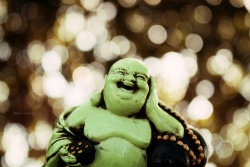How Buddhist traditions are transforming - and being transformed - through their relation with Western psychology by Bhante Sujato
Psychology is an academic discipline and therapeutic practice that emerged in the cracks made by religion as it disintegrated in the West. In the late 19th and early 20th centuries, everything from mystical experience, to the belief in an afterlife, to sexual neurosis, to possession by spirits was unceremoniously stripped from religion and taken over by the psychologists; to the extent that Sigmund Freud was able to comment, “Religion is an illusion and it derives its strength from the fact that it falls in with our instinctual desires.”
Little wonder that religious people are often defensive when psychology is in the air, with its secularism and its skepticism. But there is a counter current to this seemingly inevitable process. William James is reported to have said to a Buddhist monk who came to one of his lectures: “Take my chair. Yours is the psychology everyone will be studying 25 years from now.”
This event is regularly quoted in Buddhist circles as a sign that Buddhist psychology is the direction that western psychology is headed. But notice also that the opposite is true: the Buddhist monk (who some say was Anagarika Dharmapala) was interested enough in western psychology that he wanted to hear what James had to say.
Psychology and Buddhism have much to offer each other, when they are willing to listen and understand with humility. Psychology offers a detailed understanding of psychological development and the formation and nature of mental illness that is far more detailed than anything found in Buddhism. And Buddhism offers contemplative techniques that have been repeatedly proven to be uniquely effective, not only in relieving symptoms of mental illness, but in expanding consciousness to heights unsuspected by Freud.
As the anecdote of James shows, the intersection between Buddhist and psychology, while it has taken flight in the past few decades, is much deeper than that. These two disciplines have been in a symbiotic relationship since the dawn of the modern era. Buddhist ideas were very much current in European intellectual circles in the days of Freud. And new western ideas were very much current in Buddhist lands, many of which were colonies, and all of which were forging new “modernist” forms of Buddhism that enabled their ancient faith to find a new lease of life in this new and dangerous world. Much of what we consider today to be “traditional Buddhism” was in fact invented in the early 20th century, as Buddhists responded to western critiques by developing rational, psychologized versions of ancient Buddhist practices.
The best known of these innovations is the so-called “vipassana” meditation movement. This emerged from a secularization of Buddhist practice. Stripped of ritual and superstition, meditation was henceforth to be a purely inner process of mindful awareness. In this way, the influence of modernity performed a great service for Buddhism, prompting an unprecedented re-invigoration of meditation, a practice that had previously been mostly ignored, or marginalized to the mystical experiences of dubious quasi-shamanic wild monks. This enabled meditation to flourish in “value-free”, secular contexts; to be widely adopted by other faiths; to be implemented in prisons, hospitals, and the like; and to be studied using the quantifiable methods of western science.
But there is a nagging feeling: what has been left behind? Is Buddhism to be stripped of its riches and left as a bland devotional cult while the cutting-edge is adopted by the secularists? Is a meditation technique, divorced of its context of ethics and philosophy, able to deliver the same transformation? While the vipassana movement has, without doubt, accomplished an astonishing feat in bringing meditation to the west, the task is still only beginning.
As a former practitioner of vipassana, I can attest first-hand to the fear of emotions that is often taught in that practice. Pleasure, especially, is fearful and to be shunned as a source of attachment. In this I see the unconscious influence of Buddhism’s western critics like Freud, who argued that meditative absorption was a mere infantile regression to the oceanic immersion in the womb. The vipassana schools responded by rejecting pleasure, and rejecting absorption. Whether or not this hypothesis is correct, one thing is clear: such fear has no basis in the Buddha’s teachings as recorded in the early scriptures, the Pali Nikayas and Chinese Agamas. There, pleasure is seen as, not an obstacle, but the very key to all deeper meditation experiences.
As the influence of Buddhism on psychology grows, therapists who are Buddhist meditators are becoming increasingly aware of this. The fear of pleasure is becoming more muted, and being disposed altogether. The way of approaching vipassana is shifting, becoming gentler, more accepting of emotions, more appreciative of pleasure. As therapists, they are all to aware of the damaging effects of an excessively intense or severe approach to meditation.
As this process goes on among the psychologists, meditation among Theravadin Buddhists is also changing. Three decades ago, almost no-one was teaching samatha (tranquillity) meditation internationally. Gradually, a few rebels appeared, championing the value of absorption meditation (jhanas), and speaking of the role of pleasure in leading to such deep states. One of the pioneers was the first Australian bhikkhuni, Ayya Khema, and soon after our very own Ajahn Brahm. In the US, Venerable Thanissaro, in Malaysia Bhante Dhammavuddho; and in the late 90s Burma’s Pa Auk Sayadaw emerged as one of the leading meditation teachers in that former bastion of pure vipassana.
It is quite remarkable that this movement towards a greater acceptance of samatha meditation has been happening, in parallel and with mutual influence, in both the Theravada bastion of Burmese monasticism, and in the secularist heartland of American Buddhist psychotherapy. No, they are not doing exactly the same thing, but there is a clear and strong connection.
I suggest that, as we see this connection unfold, we are merely seeing the latest chapter in a book that started at the very latest in the late 19th century, with the mutual influence of modern Buddhism and psychotherapy. This will not be the last.
What will the next chapter read like? If I was to hazard a speculation, I would say it will not be meditation. The integration of meditation in western psychology is already approaching completion. Of course, there is much to be done, but that will in terms of expanding and refining existing models and applications. Essentially, both modern Buddhism and psychotherapy agree on the topic of meditation.
What they substantially disagree on is eschatology: what happens when we die? This is a question that clearly has significant psychological impact. It changes the very orientation and meaning of life. As we have seen in the context of meditation, Buddhists responded to western scientific and skeptical critiques of rebirth by modifying or in some cases rejecting the notion of rebirth; and the rejection of rebirth is a commonplace in psychological Buddhism. Yet the vast majority of people, Buddhist or not, believe in rebirth; and it is a mere unfounded assertion to say that they are deluded by their fear of death. It is just as plausible, given that both Freud and the Buddha spoke of a death-wish, to argue that the secularists reject rebirth because of an unconscious longing for annihilation. Neither of these arguments, however, are useful: they use psychology in the wrong way, to dismiss those who are different rather than to understand them. The test of whether a belief is neurotic or not is whether it is beneficial. Clearly many people find belief in an afterlife to be beneficial, so it is unreasonable to dismiss it as a mere delusion. Psychology itself, as repeatedly emphasized by Jung, cannot make judgements about the truth or otherwise of such claims.
The evidence for rebirth, among psychologists, biologists, and others, is strong and growing stronger. In the next generation, I suspect we will see a major shift in perspective. The annihilationists will gradually fade away as the reality of rebirth becomes harder to deny. At the same time, following the pattern of mutual influence, Buddhist ideas will change; while scientific data appears to confirm certain aspects of Buddhist ideas of rebirth, there is no guarantee that it will confirm every aspect of Buddhist teachings. In fact, it is virtually inevitable that it will not. We need to stop using science merely as a tool to validate Buddhist when it is convenient, and start meaningfully considering what the intersection of Buddhism and science implies. For example, in the findings of Ian Stevenson, there does not appear to be any support for the widely-accepted Buddhist notion that your mind state at the time of death will determine your rebirth. Does this mean we must reassess our notions of rebirth? Or is it merely the incomplete state of the evidence?
Buddhists and psychologists will increasingly come to recognize that questions of ultimate meaning and human destiny are not just theoretical or abstract notions, but among the very core concerns of spiritual or psychological development. Accepting, debating, integrating, and dealing with the implications of these difficult matters will, I believe, be the next frontier in the integration of Buddhism in modernity.
One final comment. There are many who feel that Buddhism is watered down, distorted, or corrupted by its encounter with the west. This is wrong, and frankly such ideas can only be the product of someone who has never spent much time in a Buddhist country. Of course Buddhist is watered down and distorted - has it ever been the case that in any place at any time, there’s a nation of Buddhas just wandering around? Buddhist culture is no more a perfect embodiment of what the Buddha taught than Christian culture really reflects the teachings of the Jewish prophet who told his followers to give away all they possessed and follow him.
A little history teaches us that when Buddhism arrives in a new culture, it finds its way by adapting elements of the old culture, allowing those who are satisfied with tradition forms of animist worship to continue to do so, as long as they give up cruel sacrifices and the like. Bits of Buddhist philosophy make their way among the philosophers, meditation practices are undertaken by a few yogis, devotional cults spring up for the masses, simple ethical teachings are preached, stories and local art forms are adapted to Buddhist forms, and so on. This is all no different in principle from what is happening in the west today.
Of course the Buddhism that is accepted in psychology is not the complete fullness of everything that was taught and realized by the greatest sage who ever lived - how could it be? Of course the psychologists will pick and choose, leaving aside those bits they can’t digest - but maybe can later. Since modern western culture is in many ways quite different than any of the other cultures that Buddhism has taken root in in the past, the details of this process will differ greatly. The conversion narratives of Buddhism in the west do not feature the taming of child-eating goblins. It does feature the transformation of psychotherapy. And this will be something of momentous significance for both psychotherapy and Buddhism.



